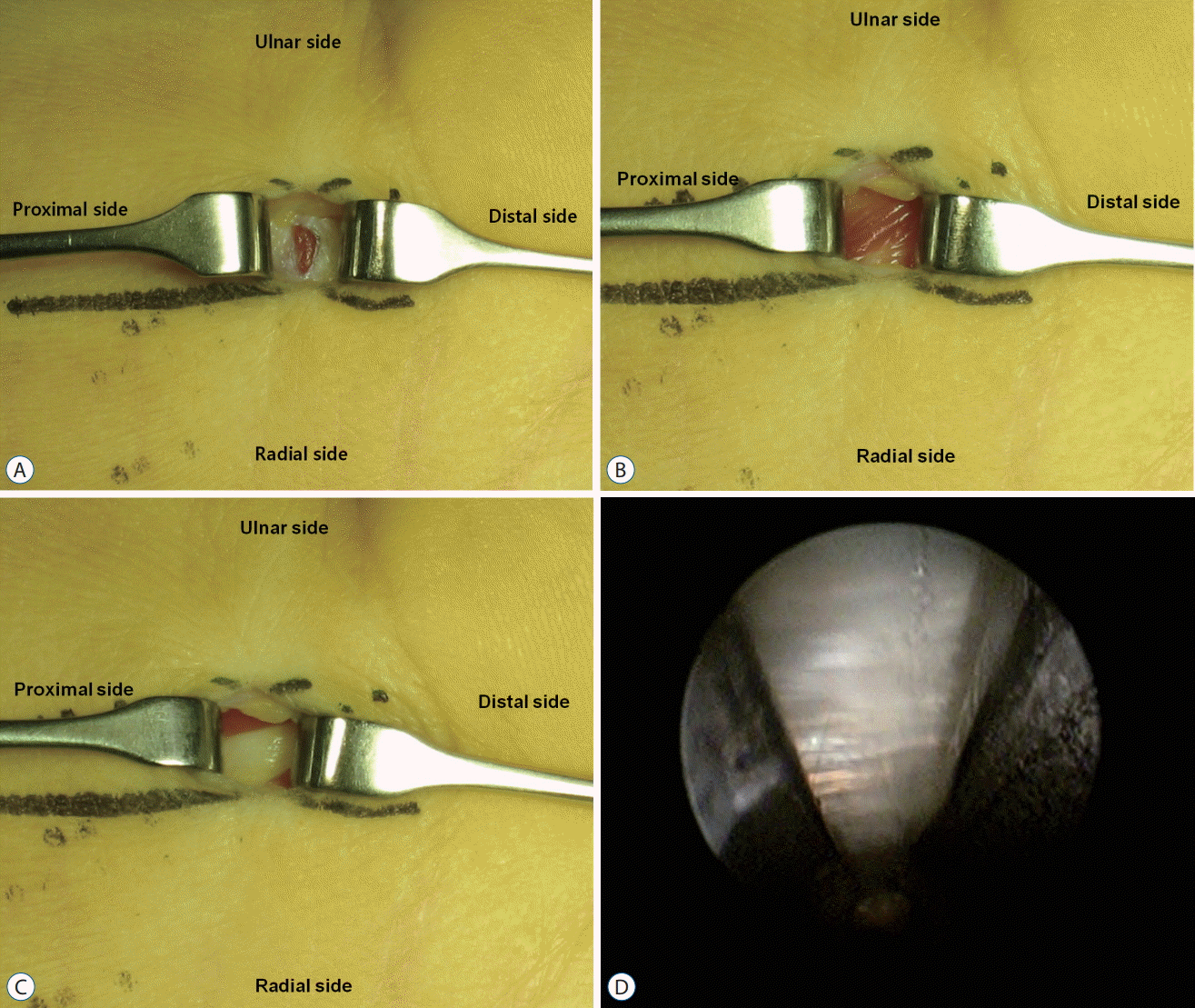1. Backhouse KM, Churchill-Davidson D. Anomalous palmaris longus muscle producing carpal tunnel-like compression. Hand. 7:22–24. 1975.

2. Basu SS, Hazary S. Variations of the lumbrical muscles of the hand. Anat Rec. 136:501–504. 1960.

3. Chen L, Duan X, Huang X, Lv J, Peng K, Xiang Z. Effectiveness and safety of endoscopic versus open carpal tunnel decompression. Arch Orthop Trauma Surg. 134:585–593. 2014.

4. Chou HC, Jeng H, Ko TL, Pai MH, Chang CY, Wu CH. Variant palmaris profundus enclosed by an unusual loop of the median nerve. J Anat. 199(Pt 4):499–500. 2001.

5. Christensen S. Anomalous muscle belly of the flexor digitorum superficialis in two generations. Hand. 9:162–164. 1977.

6. De Smet L. Median and ulnar nerve compression at the wrist caused by anomalous muscles. Acta Orthop Belg. 68:431–438. 2002.
7. Dodds GA 3rd, Hale D, Jackson WT. Incidence of anatomic variants in Guyon’s canal. J Hand Surg Am. 15:352–355. 1990.

8. Elias LS, Schulter-Ellis FP. Anomalous flexor superficialis indicis: two case reports and literature review. J Hand Surg Am. 10:296–299. 1985.

9. Fatah MF. Palmaris profundus of Frohse and Fränkel in association with carpal tunnel syndrome. J Hand Surg Br. 9:142–144. 1984.

10. Jeffery AK. Compression of the deep palmar branch of the ulnar nerve by an anomalous muscle. Case report and review. J Bone Joint Surg Br. 53:718–723. 1971.
11. Kaplan EB. Muscular and tendinous variations of the flexor superficialis of the fifth finger of the hand. Bull Hosp Joint Dis. 30:59–67. 1969.
12. Kawashima T, Kikushima S, Yokota E, Ohkubo F, Yamana Y, Sato F, et al. A case of an accessory palmaris longus muscle and a duplicate palmaris longus muscle with special reference to their nerve supply--morphologic significance of a common innervation trunk. Okajimas Folia Anat Jpn. 79:75–81. 2002.

13. Lahey MD, Aulicino PL. Anomalous muscles associated with compression neuropathies. Orthop Rev. 15:199–208. 1986.
14. McClelland WB Jr, Means KR Jr. Palmaris profundus tendon prohibiting endoscopic carpal tunnel release: case report. J Hand Surg Am. 37:695–698. 2012.

15. Mehta HJ, Gardner WU. A study of lumbrical muscles in the human hand. Am J Anat. 109:227–238. 1961.

16. Michelotti B, Romanowsky D, Hauck RM. Prospective, randomized evaluation of endoscopic versus open carpal tunnel release in bilateral carpal tunnel syndrome: an interim analysis. Ann Plast Surg 73 Suppl. 2:S157–S160. 2014.
17. Middleton WD, Kneeland JB, Kellman GM, Cates JD, Sanger JR, Jesmanowicz A, et al. MR imaging of the carpal tunnel: normal anatomy and preliminary findings in the carpal tunnel syndrome. AJR Am J Roentgenol. 148:307–316. 1987.

18. Park MJ, Namdari S, Yao J. Anatomic variations of the palmaris longus muscle. Am J Orthop (Belle Mead NJ). 39:89–94. 2010.
19. Park SH, Cho BH, Ryu KS, Cho BM, Oh SM, Park DS. Surgical outcome of endoscopic carpal tunnel release in 100 patients with carpal tunnel syndrome. Minim Invasive Neurosurg. 47:261–265. 2004.

20. Polesuk BS, Helms CA. Hypertrophied palmaris longus muscle, a pseudomass of the forearm: MR appearance--case report and review of the literature. Radiology. 207:361–362. 1998.

21. Posch JL, Marcotte DR. Carpal tunnel syndrome: an analysis of 1,201 cases. Orthop Rev. 5:25–35. 1976.
22. Probst CE, Hunter JM. A digastric flexor digitorum superficialis. Bull Hosp Joint Dis. 36:52–57. 1975.
23. Ragoowansi R, Adeniran A, Moss AL. Anomalous muscle of the wrist. Clin Anat. 15:363–365. 2002.

24. Sebastin SJ, Puhaindran ME, Lim AY, Lim IJ, Bee WH. The prevalence of absence of the palmaris longus--a study in a Chinese population and a review of the literature. J Hand Surg Br. 30:525–527. 2005.

25. Sookur PA, Naraghi AM, Bleakney RR, Jalan R, Chan O, White LM. Accessory muscles: anatomy, symptoms, and radiologic evaluation. Radiographics. 28:481–499. 2008.

26. Stecco C, Lancerotto L, Porzionato A, Macchi V, Tiengo C, Parenti A, et al. The palmaris longus muscle and its relations with the antebrachial fascia and the palmar aponeurosis. Clin Anat. 22:221–229. 2009.

27. Thompson NW, Mockford BJ, Cran GW. Absence of the palmaris longus muscle: a population study. Ulster Med J. 70:22–24. 2001.
28. Timins ME. Muscular anatomic variants of the wrist and hand: findings on MR imaging. AJR Am J Roentgenol. 172:1397–1401. 1999.

29. Touborg-Jensen A. Carpal-tunnel syndrome caused by an abnormal distribution of the lumbrical muscles. Case report. Scand J Plast Reconstr Surg. 4:72–74. 1970.

30. Troha F, Baibak GJ, Kelleher JC. Frequency of the palmaris longus tendon in North American Caucasians. Ann Plast Surg. 25:477–478. 1990.

31. Vasiliadis HS, Georgoulas P, Shrier I, Salanti G, Scholten RJ. Endoscopic release for carpal tunnel syndrome. Cochrane Database Syst Rev. (1):CD008265. 2014.

32. Zeiss J, Guilliam-Haidet L. MR demonstration of anomalous muscles about the volar aspect of the wrist and forearm. Clin Imaging. 20:219–221. 1996.

33. Zeiss J, Jakab E, Khimji T, Imbriglia J. The ulnar tunnel at the wrist (Guyon’s canal): normal MR anatomy and variants. AJR Am J Roentgenol. 158:1081–1085. 1992.

34. Zeiss J, Jakab E. MR demonstration of an anomalous muscle in a patient with coexistent carpal and ulnar tunnel syndrome. Case report and literature summary. Clin Imaging. 19:102–105. 1995.






 PDF
PDF Citation
Citation Print
Print


 XML Download
XML Download